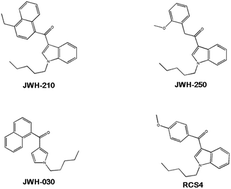Synthetic cannabinoid, JWH-030, induces QT prolongation through hERG channel inhibition†
Abstract
The problem of new psychoactive substance (NPS) abuse, which includes synthetic cannabinoids, is emerging globally, and the cardiotoxicity of these synthetic cannabinoids has not yet been evaluated extensively. In the present study, we investigated the effects of synthetic cannabinoids on the cytotoxicity, human Ether-à-go-go-related gene (hERG) channel, action potential duration (APD), and QT interval. The 3-(4,5-dimethylthiazol-2-yl)-2,5-diphenyltetrazolium bromide (MTT) assay showed that JWH-030 was more cytotoxic than JWH-210, JWH-250, and RCS4 in H9c2 cells at 0.1 μM. In addition, the cytotoxicity was associated with its pro-apoptotic effects as evidenced by the increase in caspase-3 levels. We demonstrated that a cannabinoid receptor type 2 (CB2) antagonist, AM630, inhibited JWH-030-induced cytotoxicity, whereas a CB1 antagonist, rimonabant, did not. Furthermore, fluorescence polarization assay showed JWH-030 to block the hERG channel (half-maximal inhibitory concentration, IC50 was 88.36 μM). JWH-030 significantly reduced the APD at 90% repolarization (APD90) in rabbit Purkinje fibers and decreased the left ventricular end diastolic pressure (LVEDP) in Langendorff-perfused Sprague-Dawley (SD) rat hearts at 30 μM. In addition, the electrocardiogram (ECG) measurement revealed that the intravenous injection of JWH-030 (0.5 mg kg−1) prolonged the QT interval in SD rats. These results suggest that JWH-030 is cytotoxic and its cytotoxicity is mediated by its action on the CB2 receptor; it prolongs the QT interval by regulating ion current channels and APD.


 Please wait while we load your content...
Please wait while we load your content...